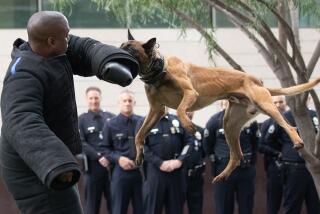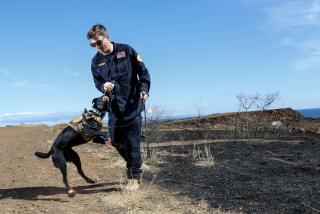War dogs called to front lines again and again
WASHINGTON — Rambo sounds the warning as soon as the kennel door at Bolling Air Force Base creaks open -- a ferocious, thunderous bark as loud and persistent as a jackhammer. In nearby stalls, Rocky goes berserk, spinning in tight circles like a top, and Jess, ears perked, bounces excitedly up and down.
Then there’s Timi. He stays silent, his head bowed, ears bent. He stands motionless, averting his gaze.
Timi has always been the oddball of the kennel, “the quirky one,” said Air Force Staff Sgt. Timothy Evans, his trainer. The dog is an Iraq war veteran, and according to his medical file, he has nightmares “characterized by violent kicking.” His veterinarian says he has had “readjustment issues” since coming home -- although not severe enough to prevent him from returning to the field.
The wars in Iraq and Afghanistan aren’t just forcing thousands of soldiers and Marines to deploy for two and three tours. The sacrifice is being shared by a key, and growing, part of the U.S. military: highly trained German shepherds and Belgian Malinois. In a war with no front lines, they have become valuable at sniffing out makeshift bombs.
The use of dogs in war, whether as scouts, sentries or trackers, goes back hundreds of years. But since Sept. 11, 2001, the Defense Department has increased the number of military dogs to 2,025 from 1,320, and many have served multiple tours.
Some service members say the dogs’ ability to sniff out bombs and insurgents makes them indispensable. And they think that the dogs’ heroism should be rewarded.
The U.S. War Dogs Assn. is trying to persuade the Pentagon to create a medal for dogs. Another group is pushing for a military working dog memorial in the Washington area. And the Humane Society, which criticized the Pentagon during the Vietnam War, when many dogs were left behind or euthanized, has credited the military with working to find retirement homes for them.
Like new recruits, the dogs enter the military through boot camp, where they learn the canine version of soldiering: basic obedience and how to detect explosives, navigate obstacle courses and sneak up on a house without barking. They are exposed to the rat-tat-tat of rifles, loud noises and explosions so they can learn to stay cool under fire. Although they are taught to bite and hold the enemy, they are not trained to kill, officials said. By the time they are ready for the battlefield, the Pentagon has invested $15,000 in each dog.
It’s impossible to estimate how many lives the dogs have saved, said Master Sgt. Robert Tremmel, manager of the Air Force’s working dogs program at Lackland Air Force Base in San Antonio, where the dogs and dog trainers are initially trained.
In Iraq and Afghanistan, “they’re finding ammunition,” Tremmel said. “They’re finding weapons -- AK-47s and caches and a lot of unexploded ordnance. . . . They’re invaluable.”
There have also been numerous accounts of dogs being used to intimidate detainees during interrogations in Iraq and elsewhere. One of the most notorious photos from the Abu Ghraib prison scandal was of a dog handler holding a dog inches from a detainee’s face. The handler was one of two soldiers convicted of using dogs to intimidate detainees.
And officials at Guantanamo Bay, Cuba, began using dogs to intimidate detainees during interrogations in late 2002, after then-Defense Secretary Donald H. Rumsfeld approved techniques that used “detainees’ individual phobias (such as fear of dogs) to induce stress,” says a military memo signed by Rumsfeld.
At Andrews Air Force Base, two dog teams were recently deployed. In addition to military dogs, 38 contractor dog teams are in Afghanistan and about 140 dogs are in Iraq. Since the Sept. 11 terrorist attacks, 11 military dogs have been killed in combat, Tremmel said.
Former Air Force Tech Sgt. Harvey Holt and his dog, Jackson, were pinned down by sniper fire in 2006 outside Baqubah, north of Baghdad. During a break in the fire, he took his dog, a Belgian Malinois, through the field to find the sniper. Jackson picked up a scent, sprinted toward a bale of hay, jumped in and pulled the sniper out by his calf, Holt said.
Like other handlers, Holt was often attached to many different units. As a result, Holt didn’t form bonds with other soldiers, but rather with his dog. On cold nights, they shared a sleeping bag.
“We were two heads poking out of the bag,” he said. “If it weren’t for the dog, I probably wouldn’t have made it emotionally there.”
More to Read
Sign up for Essential California
The most important California stories and recommendations in your inbox every morning.
You may occasionally receive promotional content from the Los Angeles Times.










